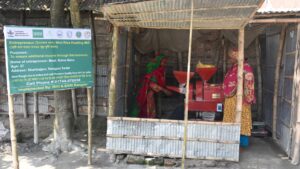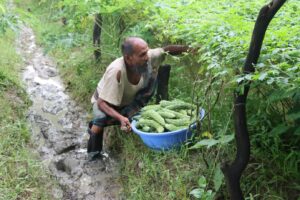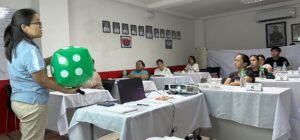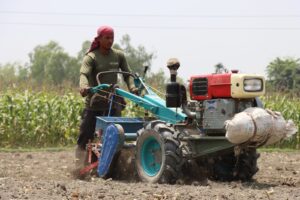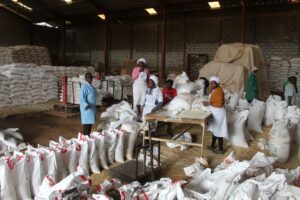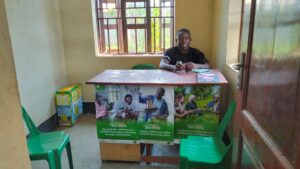Persuading farmers to try out and consequently adopt new practices is challenging. Adoption rates of CSA practices in Indonesia are low. Increasingly, agricultural extension agents serve as intermediaries to enhance communication between technology developers and farmers. The CORIGAP project recognized that single, isolated interventions are unlikely to be sufficient for sustainable, climate-friendly rice production and, therefore, promoted a variety of sustainable practices and technologies.
The Global South is prone to extreme climate events such as droughts, high temperatures, erratic rainfall, and floods that threaten sustainable agricultural development. Smallholder farmers are among the most vulnerable people affected by extreme climate events. In response, a suite of agricultural technologies and practices, known collectively
as climate-smart agriculture (CSA), has been developed and promoted.
CSA has three objectives:
(i) increase agricultural productivity to support food security and broader development goals;
(ii) increase adaptive capacity and resilience to climate variability and
(iii) decrease greenhouse gas emissions
CSA includes, among others, climate-adapted crop varieties and improved land management practices. CSA is critical to agricultural development and the realization of several Sustainable Development Goals (SDGs).
Numerous climate change mitigation and adaptation initiatives worldwide encourage farmer adoption of CSA.
CSA is of particular interest to smallholder farmers in Indonesia who manage a plethora of climate-related risks, including droughts, flooding, and changing monsoonal activities. Such phenomena have adverse effects on the size of rice cultivation areas, delay planting times, and decrease rice yields. Smallholder rice farmers in Jakenan, Central Java use climate forecasts in decision making especially to determine planting time and select crop varieties.
The combination of saline-tolerant rice varieties and improved nutrient management use is a good strategy for improving farmers’ livelihoods while promoting sustainable rice production. In the riparian wetlands of South Sumatra, intensive observation of farmer’s practices and dialogues with farmers about their constraints intensifying food production have revealed the needs, preferences, and absorptive capacity of smallholder rice farmers.
The Special Region of Yogyakarta is situated in southern Java bordering the Indian Ocean. On Java, approximately 29% of the rice-growing areas are within 10 km of the coast. In recent years the productivity of paddy fields has decreased particularly during the dry season. In response, development projects have promoted CSA.
CSA practices were introduced to Yogyakarta as early as 2012 through the Closing Rice Yield Gaps in Asia (CORIGAP) project funded by the Swiss Agency for Development and Cooperation (SDC). Improved rice varieties, alternate wetting and drying (AWD), drum seeders, mechanical transplanters, combine harvesters, and Super Bags for storage were introduced over a timeframe of four years via adaptive participatory processes.
Persuading farmers to try out and consequently adopt new practices is challenging. Adoption rates of CSA practices in Indonesia are low. Increasingly, agricultural extension agents serve as intermediaries to enhance communication between technology developers and farmers. The CORIGAP project recognized that single, isolated interventions are unlikely to be sufficient for sustainable, climate-friendly rice production and, therefore, promoted a variety of sustainable practices and technologies.
An adaptive, participatory diffusion process can more readily factor in the heterogeneity of farmers’ needs and support priority setting at the local level compared to the more common top-down approach. CORIGAP thus periodically organized demonstration sites, farmer field schools, and trainings interventions are unlikely to be sufficient for sustainable, climate-friendly rice production and, therefore, promoted a variety of sustainable practices and technologies.
We investigated the uptake of CSA practices and technologies that CORIGAP promoted in Yogyakarta. We analyzed a three-step process: awareness, trial, and adoption. Furthermore, we investigated the contribution of farmer adoption to social, economic, and environmental change.
Such understanding is critical in order to determine whether extant theories of change reflect actual processes linking research outputs to outcomes and impacts, or whether changes in project design and implementation are required in order to generate greater impact.
The Indonesia study is an example of the evolution of the climate-resilient farming system.
The results of the present study demonstrated that farmers adopted CSA, especially improved varieties and AWD. However, some farmers indicated that they had difficulties applying CSA especially machinery, which was difficult to source. Farmers invested their additional income into the farming business and improved diets. Farmers perceived a significant change in social and human capital indicating knowledge acquisition and dissemination of CSA.
In addition, farmers also perceived a reduction in poverty levels due to the adoption of CSA. The overall perception of change was determined by the number of CSA technologies and practices adopted. The present study highlights the links between on-farm development outputs, outcomes, and impact, and provides a case study for the evolution of climate-resilient farming systems.
Read the study:
Connor M, de Guia AH, Pustika AB, Sudarmaji, Kobarsih M, Hellin J. (2021) Rice Farming in Central Java, Indonesia—Adoption of Sustainable Farming Practices, Impacts and Implications. Agronomy: 11, 881.

